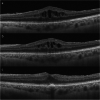Topical NSAIDs, intravitreal dexamethasone and peribulbar triamcinolone for pseudophakic macular edema
- PMID: 34740334
- PMCID: PMC8570006
- DOI: 10.1186/s12886-021-02132-w
Topical NSAIDs, intravitreal dexamethasone and peribulbar triamcinolone for pseudophakic macular edema
Abstract
Background: The purpose of this study is to assess the effectiveness of topical nonsteroidal anti-inflammatory drugs (NSAIDs) and corticosteroids (intravitreal dexamethasone and peribulbar triamcinolone) in treating pseudophakic macular edema (PME).
Methods: Retrospective study of 33 eyes. Variables included best corrected visual acuity (BCVA; logMAR scale) and central retinal thickness (CRT) and central choroidal thickness (CCT) assessed with swept-source OCT. All patients were initially prescribed topical NSAIDs and reevaluated after 2 months. If improvement in BCVA or CRT was noted, topical NSAIDs were continued until resolution. If no improvement was observed at 2 months or subsequent visits, intravitreal dexamethasone implant was performed. Patients who refused intravitreal treatment were offered peribulbar triamcinolone.
Results: After treatment with topical NSAIDs for a median of 2 months, BCVA increased significantly from 0.5 to 0.3 while CRT decreased significantly from 435 to 316 μm. PME resolved in 19 of the 33 eyes (57.6%). Of the 14 recalcitrant cases, 13 were treated with corticosteroids. Of these 13 cases, 9 (69.2%) resolved. BCVA increased non-significantly from 0.7 to 0.4. CRT and CCT decreased significantly from 492 to 317 μm and from 204 to 182 μm respectively.
Conclusions: The overall success rate of the treatment algorithm was greater than 80%, a remarkable finding considering that no randomized study has yet been conducted to determine the optimal therapeutic protocol for PME. This is the first study to evaluate choroidal thickness in PME using SS-OCT, which could play a key role in its pathophysiology and provide useful information to improve the management of PME.
Keywords: Central choroidal thickness; Central retinal thickness; Intravitreal dexamethasone; Peribulbar triamcinolone; Pseudophakic macular edema / Irvine Gass syndrome; Topical NSAIDs.
© 2021. The Author(s).
Conflict of interest statement
The authors declare that they have no competing interests.
Figures


References
-
- Daien V, Korobelnik J-F, Delcourt C, Cougnard-Gregoire A, Delyfer MN, Bron AM, Carrière I, Villain M, Daures JP, Lacombe S, Mariet AS, Quantin C, Creuzot-Garcher C. French medical-administrative database for epidemiology and safety in ophthalmology (EPISAFE): the EPISAFE collaboration program in cataract surgery. Ophthalmic Res. 2017;58(2):67–73. doi: 10.1159/000456721. - DOI - PubMed
MeSH terms
Substances
LinkOut - more resources
Full Text Sources
Research Materials

